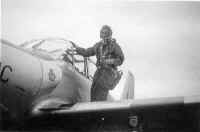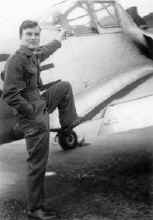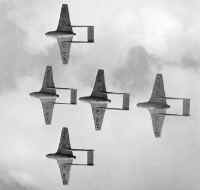| RAF Feltwell - Personnel - memorial pages. |
Photo pages -> |
|||||||
|
|
|
|
||||||
| Recollections | RAF Feltwell History | RAF Feltwell Planes & Buildings | 75 NZ Squadron |
|
|
|
|
|
| Back to articles |
RAF FELTWELL MEMORIES By Barry Davies 3 FLYING TRAINING SCHOOL 1955/56 |
| This is the official shot of 20 wannabee pilots
in front of a Provost trainer, taken the morning after their arrival at
Feltwell for the 9 month course. Ten of the students are National
Servicemen, ten are career regulars and one is an overseas officer from
the Iraqi Air Force (in King Feisal days). Most were aged between 18 and
21.
The previous evening they had attended a newcomers’ party run by the previous course (posing as the flying instructors) and the instructors (posing as the students). Some of the more gullible actually believed the horror stories of high failure rates of students and of engines, of iron discipline and fatal accidents: one actually reported at 0500hrs for PT the next morning! |
||
| The pilot had to turn the propeller of the 550
hp supercharged 12-cylinder radial engine through 3 revolutions by hand
before the first start of the day in order to clear oil settled in the
bottom cylinders. Thereafter starting was done by a Koffman cartridge
starter. But there was no starting for us until we had spent days in the
classroom first.
The first few weeks of the course were spent covering a large range of subjects... theory of flight, navigation, aircraft and engine systems, meteorology, radio, aviation medicine ... and so forth. Subsequently our teachers gave us written exams. Failure to achieve a pass meant being chopped from the course. |
||
| It was the proud boast of our Radio lecturer that no one had ever scored full marks in the exam he had set in this subject. He had a question which floored everybody, although, as he told us, the answer was very clearly written in the Air Pilot manual. He maintained that embryo pilots must be dim never to offer the correct answer to the question ‘What is the correct speed for voice transmission on VHF/RT radio?’. The answer? Not too fast and not too slow! | ||
| But soon the flying started. We all achieved that important first solo, some sailed through and others only after airsickness, extra tuition and confidence-boosting by their instructor. These latter were masters of psychology, iron nerved and dedicated. | ||
| The training was superb. On the principle that you only learn from your mistakes these heroes intervened only at the very last minute to forestall the dire results of a pupil’s error. They bonded with all our different personalities to build in us all a feel for the seat of the pants basic skills, creating a confidence in handling the aircraft to its limits. And they insisted on very precise and accurate flying. The need for this was evident when flying in close formation, in instrument flying in a crowded circuit at night, in tail chasing and low flying. | ||
| Our low flying area was South of Downham Market, we called it the twin canals. This photo was set up when one of us catching up on flying hours was tasked to fly, unusually, on a Saturday. We drove to a planned rendezvous and asked for a low fast fly by. Dogleg obliged, as can be seen, having posed earlier before take off as seen here. |  |
|
| This picture shows ‘Dogleg’ Dibben with ‘Pegleg’
Pavitt, ‘Blondie’ Spain & ‘Tonkers’ Tompkinson outside No 3
hangar.
As the Course progressed we had only one minor accident when one of us, subsequently called Pegleg, wiped off an undercarriage leg on landing. We had a few near misses the night 10 of us were night flying on a cross country over Peterborough and Oakington when an unexpected thunderstorm made visibility nearly zero and one of us lost himself in the home circuit. But by and large we became a relatively competent team, something about flying in close formation in cloud building a mutual trust and reliance. |
||
| Our low flying and favourite aerobatic area was over the
twin canals South of Downham Market; the railway line alongside the
airfield was also an attractive place for low level airfield circuits. But
best of all were the low-level navigation exercises, not below 250ft,
which were planned to route through Brandon, Metfield, Acle, Foulsham and
Swaffham. These included the forest of Thetford Chase with fire breaks in
the forest which allowed a very low and unexpected arrival at the
firewatchers’ wooden look out buildings.
We used to look for interesting places to visit in off duty hours. One such place was off the runway end of Methwold -Didlington Hall - which was a superb old stately home , unoccupied and derelict, with the most Rococo of swimming pools where we frequently trespassed. Then there were The Bull at Barton Mills, the pub in Cambridge (opposite the labs where the first atom was split) with US bomber crew names written in candle smoke on the ceiling. And a local Church shown in the photo... can anyone identify it? |
 |
|
|
|
One of us had an MG TC for these excursions off
base and we also had a Standard 10 which we used for playing at instrument
flying. One of us in the passenger seat issued instructions and operated
the gear stick, floor pedals were operated by another in the drivers
footwell, steering by a passenger footwell operative. This driving
technique was perfected to a fine art, but wisely was never again operated
outside of the airfield after one occasion when it ran off the public
highway into a field of beet.
Recovery from unusual positions was, however, a part of the syllabus on the course and repairs were quickly effected. A suggestion that ‘The undertaking of repairs in the field ‘ might be added to the ground school training was not taken up. |
|
| 'Bim' Davies established something of a record claim. After
his first solo in an aircraft he passed his driving test locally and only
then did he go solo on a bicycle for the first time. This first solo was
on the grass because he had been told by the driving instructor that he
shouldn’t drive so fast past parked vehicles till he had more practice.
That afternoon he was back formation flying at 140knots. |
 |
|
| Round about March several members of the newly re-forming German Air Force spent a week with us on refresher training. Amongst them was the celebrated Major Krupinski, one of the topmost Luftwaffe aces with 197 confirmed victories (mostly on the Eastern Front in Russia) to his credit. The senior FTS flying staff had a fine time exchanging reminiscences with them in the bar but we were told not to talk about their presence in the village in case of provoking local hostility. The London papers got hold of the news anyhow but no untoward results ensued. | ||
| The US base at Lakenheath was
very close to the Feltwell circuit and we used to share the local airspace
with their operations which included B 47 Stratojetbombers and their
flight refuelling tankers, and several secret U2 spy planes. These later
gained fame when Gary Powers was shot down whilst on a CIA flight over flying
USSR on a high altitude spy plane missions from Turkey... The gigantic B36
Convair nuclear bombers, powered by six piston engines and four jets, also
flew in occasionally on deployment exercises direct from USA.
We used to practice Ground Controlled Approaches there in our little Provosts. Lakenheath ground radar used to transmit heading and altitude information for us to fly so we could land safely when cloud or fog made visual approach difficult. Only an American could have requested priority over an RAF Provost trainer on one of these occasions by saying, "Tell that Limey I’m 9 hours out of Texas , low on gas and with 4 burning and 6 turning". RAF Hullavington in Wiltshire was the base of 2 FTS, who were the first to operate a jet powered development of the Provost. A high level radio navigation exercise to Hullavington was part of our syllabus and made a very interesting trip. |
||
| Two of our number were tasked
with this trip on the same day. They found themselves lunching together in
the Hullavington Mess prior to their return to Feltwell, and one who lived
near Oxford said he was going to buzz his girlfriend’s house on the way
back. The other said he’d fly this first leg in formation and then split
up over Oxford in order to arrive back at Feltwell separately.
In a rush of enthusiasm while the first was circling his girlfriend’s house the other flew inverted down Oxford High St narrowly missing the Ashmolean museum and departing in a vertical upward roll. It was reported later that week in the local paper that low flying by an unidentified plane had stopped the traffic. An enquiry had been held but since it was flying upside down nobody got the number. |
||
| It was only 10 years ago that WW2
had finished, so most of the senior personnel had fought in it. There were
three much-decorated Polish fighter pilots who had been Squadron Leaders
in 1945 but had accepted being grounded and reduced to Sergeant rank in
order to avoid return to Soviet occupied Poland . They now taught on Link
Trainers, an early form of flight simulator. The base commander was an
Australian on his last appointment before retirement and previously
serving in the Middle East.
These people set the style of gung ho leadership on the ground and in preserving wartime mess parties with traditional rough and tumble games and competitions. Most of us schoolboys felt these might well have had a place in some ’for tomorrow we die’ environment of an operational bomber squadrons in wartime but they were regarded as somehow forced and out of place in what we saw as a new post-war generation. So we National Servicemen, with nothing to lose, decided to counter attack. An exercise was organised to learn the evasion techniques necessary if shot down over hostile territory (Korea was favourite) with vital secrets. We were thrown off a lorry in pairs late at night at a variety of localities with nothing except a map. We were briefed to use our initiative to evade an Army unit searching both for us and for knowledge of the secret rendezvous which was to be our escape point at 2pm the following day. All the National Servicemen arrived in good shape and on time. The others were all mud spattered ,ragged, sleepless, captured ,bleeding blistered or some combination thereof. They never discovered our secret: we took the initiative ahead of the day to book a cargo of beer, sandwiches and blankets loaded on a coach for an overnight tour of Norfolk Broads, ending at lunch just outside Methwold. This allowed small groups to stroll in one by one to the rally point unshaven but otherwise immaculate. About the same time as that was going on Messers Kruschev and Bulganin came from the USSR to Portsmouth in the heavy cruiser Sverdlovsk. The UK Government wanted to impress them with a flypast of the new RAF Valiant, first of the V bombers, and these came practising over Feltwell two consecutive lunchtimes. |
||
| Then dozens of Canberra light bombers. Then more Valiants in the same formation as previously. We all thought the Russians were smart enough to realise that these extra Valiants were in fact exactly the same aircraft as before, retracing their steps so as to appear more numerous than just the 10 serviceable examples appearing. |  |
|
| Shortly afterwards the Suez debacle occurred. An Army Air Corps squadron operated Austers from Feltwell and overnight they changed the aircraft finish from silver to sand camouflage: but it was all over before they were needed. | ||
| A side result of the conflict was
the very strict rationing of petrol. Notwithstanding this, there was a
need for RAF Feltwell to undergo the formality of the Annual Inspection by
the Air Officer Commanding. Everything had to be cleaned, painted,
polished or saluted as appropriate.
For us that meant a week with no flying while we cleaned the aircraft with neat aviation gasoline. Doubly crazy because we all used our natty white cape leather flying gloves for this and the Stores were unable to supply new ones quickly. |
||
| At the end of the day’s inspection we put
up a Formation of 13 Provosts flown by gloveless pilots in order to salute
the AOC’s departure. Apparently he flew off very pleased with his time
at 3 FTS.
This sentiment was felt at the end of October by all the graduating members of 110 Course, who left Feltwell to move on to Vampires and to earn their RAF wings. Happy Days! |
 |
|
Appendix for RAF buffs!
Feltwell opened in April 1937, had been home to various squadrons of Bomber Command until March 1946. However on that date the airfield, together with its satellite field at Methwold, was taken over by Flying Training Command in the shape of 3 FTS who filled the hangars and flight lines with open cockpit biplane Tiger Moths and 550 hp piston engined Harvards on which pupil pilots were trained up to Wings standard. (Subsequently Prentices replaced the Tigers for the basic training part of the Wings course.) The continuing use of these dated aircraft was a result of the postwar expenditure cut back forced on the RAF, for their handling characteristics were not appropriate to the learning of skills demanded by the new jet powered combat aircraft then in service. The first RAF course on these now obsolete aircraft had started in 1938 and the last finished (in fact at Feltwell) in March 1955.
Probably as a result of Soviet aircraft development evidenced by the appearance of the Mig 15 in the Korean war a priority expansion of RAF equipment was authorised. A new Provost/Vampire sequence for pilot training was introduced, the Provost at FTS and the Vampire at Advanced Flying School (AFS).
The Provost was a new post war designed basic trainer , piston engined but with very responsive controls and handling. Feltwell was one of the five FTS’s which gave a 9 month course , including 120 hours Provost flying, to pupil pilots to prepare them for their subsequent advanced flying and jet conversion at AFS on single and twin seat Vampire jets.
In 1958 Feltwell reverted to Bomber Command, when Thor Intermediate Range Ballistic Missiles (IRBM) were based there: however UK based IRBMs supplied by the USA were removed from UK in 1963 as a secret part of the resolution of the Cuban missile crisis. Subsequently Feltwell has been used as a support base for USAF activities at neighbouring Lakenheath and Methwold has reverted to civilian ownership.
SIC TRANSIT GLORIA